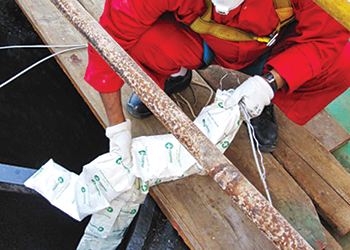Cortec corrosion technology protects key facilities
01 January 2016
Cortec Corporation’s corrosion control technologies have proven instrumental in preserving key facilities in the Middle East recently.
The US-headquartered firm recently supplied vapour phase corrosion inhibitors (VpCIs) to an offshore platform operated by Abu Dhabi Marine Operating Company (Adma-Opco), a major producer of oil and gas from offshore areas of Abu Dhabi in the UAE. The oil company operates multiple barge-type offshore platforms constructed on caisson legs.
Gas build-up inside the confined compartment around an offshore platform caisson leg led to an explosion. The gas was found to be hydrogen, generated by the depleted anodes inside the caisson leg. An investigation of the explosion made several recommendations, including removal of the anodes, biocide-treated water and blasting grit that had accumulated inside the caisson legs over two decades.
Internals of the platform caisson legs were left uncoated and filled with biocide-treated water and protected using suspended sacrificial anodes. Over time, the anodes depleted and an alternative environment-friendly method of protecting caisson legs was recommended.
A successful pilot study recommended corrosion management utilising VpCIs. To assess the effectiveness of this approach, a pilot project was launched in 2009 whereby one caisson leg was emptied and preserved with VpCIs. Carbon steel weight loss corrosion coupons were used to assess the effectiveness of this approach.
“Unlike traditional contact corrosion inhibitors, VpCIs have a moderately high vapour pressure that allows them to function in the vapour phase without applying VpCI directly to the metal surface. Therefore, VpCIs provide protection in the liquid phase, vapour phase, and critical interphase. They access the most difficult-to-reach spaces and provide effective protection against crevice corrosion,” says a spokesman for Cortec.
Within the preservation process, Cortec’s ready-to-use waterborne corrosion inhibitor VpCI-337 BD was used primarily for robust prevention of internal void spaces while simultaneously preventing bio-growth. The inhibitor was sprayed in the caisson legs to stop bio-growth. Following this, water-soluble, biodegradable powder VpCI-609 S was fogged into the void space to counter dead volume of water at the bottom. Custom manufactured strips of Cortec’s easy-to-use EcoPouch were then suspended from the top side for additional protection. EcoPouches are filled with VpCI-609 powder and constructed from breathable Tyvek, which allows the VpCI molecules to be emitted through the membrane and form a molecular layer on metal surfaces, providing corrosion protection.
The results showed strong improvement in the VpCI-treated caisson leg where corrosion rates were maintained at low rates that were deemed acceptable. The methodology was adopted for the treatment of all other caisson legs at the complex. After two years, the pilot project was deemed a success and Cortec VpCI inhibitors were proven to effectively mitigate corrosion in an offshore environment by reducing the corrosion rate in the protected leg compared to the control by 584 per cent, says the spokesman.
- Aerolon keeps corrosion at bay
- Dow cooling emulsion is in hot demand
- Cortec corrosion technology protects key facilities
- New powder coating meets region’s needs
- Fila products preserve the finest surfaces



